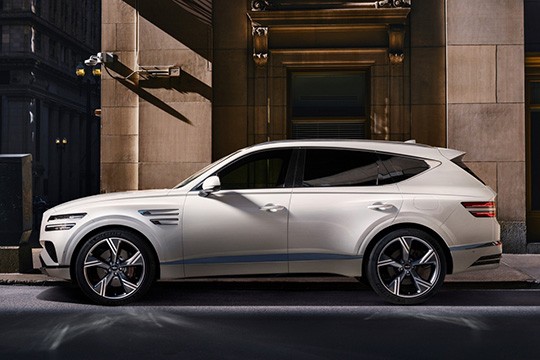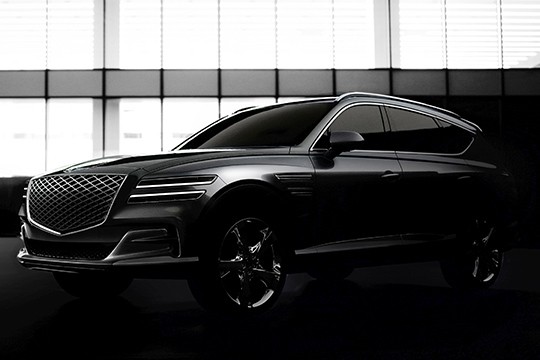GENESIS GV80 Models/Series Timeline, Specifications & Photos
First production year: 2020
Engines: Gasoline, Diesel
Body style: SUV (Sports Utility Vehicle)
Hyundai’s premium brand, Genesis, refreshed the GV80’s lineup for the 2025 model year after almost four years since the model’s introduction to the market in 2019.
The Korean automaker knew the premium segment could bring a higher profit margin than mass-market vehicles. Honda, Nissan, and Toyota did the same back in the ‘80s and ‘90s, creating the Acura, Infiniti, and Lexus, respectively. So, Hyundai followed the same recipe when it launched the Genesis brand in 2015. After introducing a few sedan vehicles, it went onto the SUV and crossover segment and made the mid-size GV80 that it unveiled in 2019. Fast forward to 2023, and the vehicle went through a well-deserved refresh that brought it a redesigned exterior and an upgraded interior.
At the front, the 2023 GV80 kept the same twin-headlight design language, where each headlamp housed an LED blade light. They flanked the massive, diamond-shaped grille that sported a rhomboidal pattern, similar to the one from the 2019 model year, but with a different styling. Furthermore, the bumper was redesigned and sported triangular side scoops and a flatter lower air intake that helped to cool the engine and the AC compressor. In addition, Genesis installed a skid plate below the apron that mimicked an aluminum underbody shield, specific for off-road vehicles.
From its sides, the refreshed 2025 GV80 featured new trims for the front fenders’ fake vents that featured turn signals. Still, the sculptured doors remained the same, and the same went with the rear quarter panels, enlarged over the wheels, like shoulders. Finally, at the back, the automaker created a new bumper, where chromed trims adorned the corners and were extended by red strips. Lower, on the apron, the automaker added two chromed elements and V-shaped trims surroundings for the side-mounted tailpipes that resembled the diamond-shaped grille.
Inside, the most significant difference was on the dashboard. The 2025 GV80 received a 27-inch OLED screen mounted atop the redesigned dashboard. This new unit replaced the system used on the 2019 model that featured a 12.3-inch display for the instrument cluster and another 14.5-inch touchscreen for the infotainment system. The leather-wrapped interior offered customers a set of heated and ventilated front bucket seats and a bench seat for three in the rear, where the outboard seats could provide warm or cold air. Another significant difference was for the audio system, which featured a Bang&Olufsen unit instead of the previously used Lexicon. Both brands are owned by Harman International, which is an independent subsidiary of Samsung.
Under the hood, the base version of the 2025 GV80 came equipped with a 2.5-liter turbocharged inline-four that sent its power in all corners via an eight-speed automatic transmission. As an option, customers could get a 3.5-liter turbocharged V6.
2021 Genesis GV80
Hyundai's luxury brand Genesis launched its first SUV in 2020 for the 2021 model year, and it tried to compete with big brands like Cadillac, Volvo, and Mercedes-Benz, to name just a few.
Since Hyundai didn't have vast experience in creating luxury cars, it hired big names from the automotive industry, such as Peter Schreyer or Luc Donckerwolke, as chief creative officer. Previously, he worked for other big European brands like Bentley, Lamborghini, and Audi within the Volkswagen Group. In 2008, the Korean luxury brand took off, and in 2015, it launched its first production vehicle, the G90, a four-door sedan. But that was not enough on a market that asked for more SUVs and crossovers. As a result, in January 2020, the automaker introduced the GV80 based on the Hyundai-Kia M3 rear-wheel-drive platform that was used for other Genesis sedans.
On the exterior, Genesis created a unique design of the front fascia with its quad-lamp design and the big, crest-like grille between them. The bumper featured a smaller, lower air intake adorned by a chicken-wire-style pattern and flanked by a pair of side scoops that diverted the air around the bodywork. From its profile, the GV80 impressed with its sloped-down roof line and the ascending window line that raised behind the rear doors. A pair of fake vents decorated the front fenders, while the sculptured doors created the image of a taller vehicle. At the back, the tailgate featured a raked forward window and a roof spoiler mounted on its upper side. The taillights were extended from the quarter panel onto the tailgate's lower panel.
The leather-wrapped interior expressed a high level of luxury. Genesis offered the car with two rows of seats as standard, while a third row placed in the trunk area was available. Thanks to Luk Donckerwolke's experience with other luxury brands, the GV80 featured diamond-stitched leather on the seats and a wide, wood-trimmed center console that housed the gear selector, two cup holders, and a storage compartment under the center armrest. Inside the instrument cluster, Genesis installed a wide speedometer on the left that also contained the fuel gauge at its bottom and two displays on its right. The one in the middle was for information gathered from the onboard computer, while the right dial showed the image from rear-view cameras installed on the left and right of the vehicle, depending on which direction the driver activated the turn signal. There was enough room in the back for three adult-sized passengers, thanks to the low transmission tunnel. The third row was mostly for kids since it provided very limited legroom and headroom, but it was there if someone needed it.
The Korean automaker offered the GV80 SUV with a choice of two turbocharged engines paired with a standard eight-speed automatic transmission. The base model had a 2.5-liter inline-four powerplant that produced 300 hp (304 PS), while the other option was a 3.5-liter V6 that produced 375 hp (380 PS). For selected markets, Genesis offered a three-liter inline-six turbo-diesel that sent 274 hp (278 PS) to the wheels. All versions were fitted with an all-wheel-drive system.

